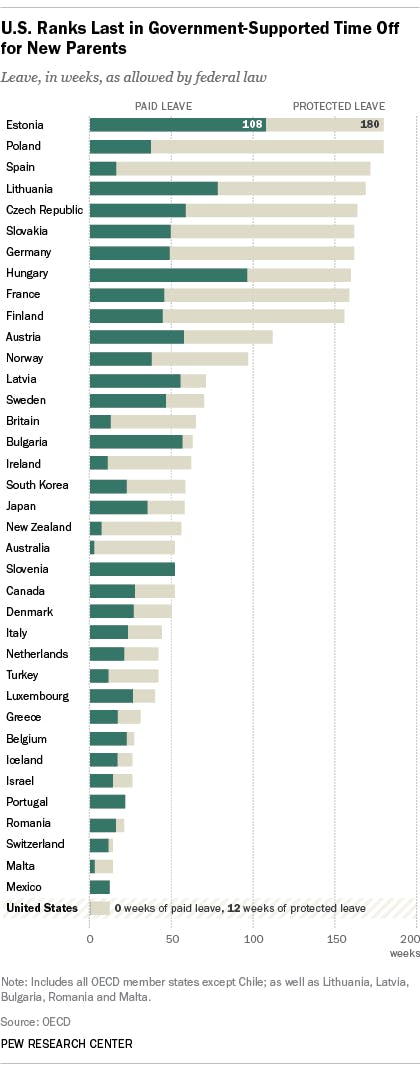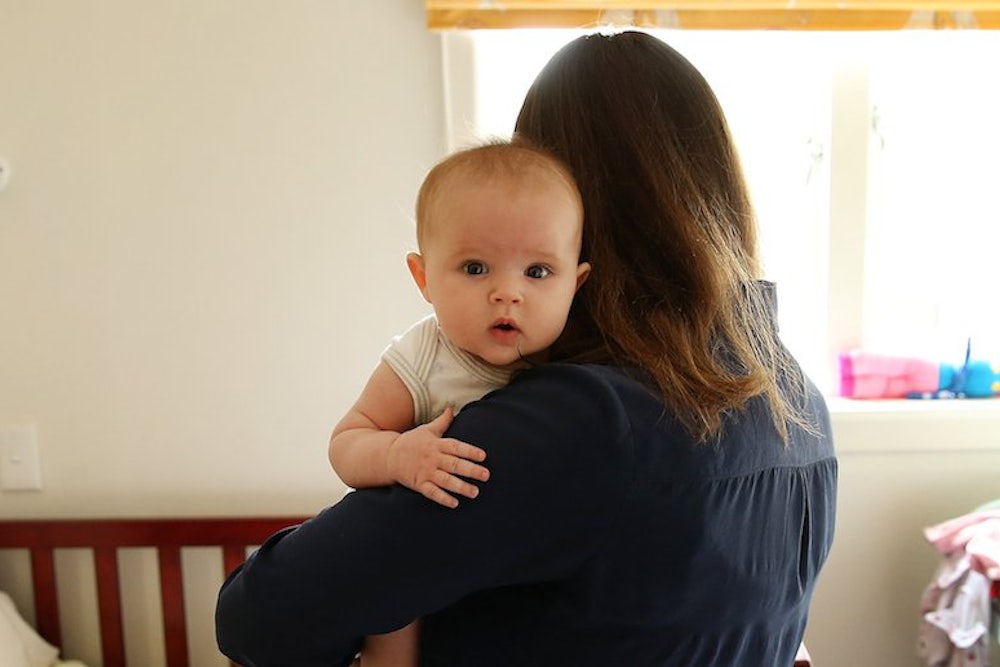The U.S. is the only developed nation still debating whether a woman should have access to paid maternity leave. More often than not, the answer to that question lies with the employer's policies; there is no federal program that covers all women in America. Outside America, the question isn’t whether paid leave is an option, but how much of it she can and should take.
The answer varies. The United Nations agency International Labour Organization recommends at least 14 weeks of paid leave. But many countries go far beyond this. For instance, the United Kingdom mandates that women receive 90 percent of their average weekly earnings for up to nine months after giving birth, and Swedish women get up to 16 months of paid leave. In many European nations, paid leave policies range anywhere from four months paid time off to over a year. The amount of protected leave, or the time a parent can care for a child without fear of losing her job, can extend even further—up to three years in places like Finland and Spain.

But how much is too much? There’s a catch to generous paid leave: When these policies are badly executed, they can reinforce the glass ceiling.
First, it's important to acknowledge that the absence of universal paid leave represents a tremendous disadvantage for working women in America. Without paid leave, women are more likely to exit the workforce. If and when they reenter, they may return to lower-paying jobs, or no job at all. Many believe that the overall lower participation of women in the workforce is a result of the lack of paid leave: Economists estimate that women’s labor force participation is lower for 25-54 year-olds than it would be in America if there were universal paid leave. The effects seem to be growing more serious: A comparative study of 22 countries found that the U.S. fell from the sixth-highest in labor force participation for women in 1990 to 17th by 2010. The Cornell economists, Francine Blau and Laurence Kahn, found that the lack of paid leave explained about one-third of this decline.
But even with paid leave, there are tradeoffs when women leave the workforce, especially for long-term leave of a year or more. Blau and Kahn write “it is plausible that the generous parental leave mandates ... reduce the likelihood that women will be able to enter high-level jobs, which generally require full-time, full-year, career-long commitments.” Long leave may allow women to extend their time away from work, but this may lead to some implicit discrimination on the part of the employer: “such policies may lead employers to engage in statistical discrimination against women for jobs leading to higher-level positions, if employers cannot tell which women are likely to avail themselves of these options and which are not,” they write.
Family-friendly policies may affect not just women in high-profile positions, but the labor force overall. In 1999, Spain passed a law protecting workers who ask for reduced hours to care for a young child. The New York Times’s Claire Cain Miller summarized the results of a study that analyzied the effects of the law: Women of childbearing age were 20 percent more likely not to be employed. “Over the next decade, companies were 6 percent less likely to hire women of childbearing age compared with men, 37 percent less likely to promote them and 45 percent more likely to dismiss them,” Miller explained.
Managers will even admit, albeit anonymously, that maternity leave factors into their hiring decisions. A survey done in the United Kingdom of 500 managers found one-third would prefer to hire a young man instead of a young woman because of maternity leave, and up to 40 percent would be wary of hiring a woman in a senior role.
Still, the majority of economists and political scientists are in agreement that the lack of paid leave is the real problem. “While there is some evidence that very long maternity leaves—in excess of 1 year—can have negative long-run effects on women's position in the labor market, we also need to pay attention to the evidence that reasonable maternity leaves—in the first year of life—improve women's position in the labor market by helping them keep and return to their jobs,” Jane Waldfogel, professor of social work and public affairs at Columbia University School of Social Work, said in an e-mail.
The solution isn’t necessarily to offer less paid leave. The trick to making sure women aren’t penalized for taking parental leave is to make sure they aren’t the only ones using it. This means focusing on fathers. Two-thirds of developed countries—including those with some of the most progressive family benefits—don't offer paid leave to fathers. The rest either offer a short duration or do a poor job of encouraging them to take advantage of existing policies.
One idea is to simply offer men and women equal parental leave rights. An idea that has caught on in many Nordic nations is the “daddy quota” or bonus—a portion of the paid leave is available exclusively to fathers, providing an added incentive for men to use their leave. “What both of these solutions have in common is the idea that if you can get both men and women to take leave, then women will be less likely to be penalized for doing so,” Waldfogel said.
Norway introduced the concept in 1993. “The entitlement cannot be passed to the mother: if it is not used, it is lost,” explains a 2013 paper from the Organization for Economic Co-operation and Development (OECD). “Currently, only the Nordic countries have a 'quota' system, with Iceland having the largest quota (3 month quota for each parent and 3 months to share). Several countries (Austria, Finland, Germany, Italy, Portugal and Sweden) provide a 'bonus' to the total period of parental leave if fathers take at least some part of the parental-leave period.” Iceland, for example, offers a total of one year of paid parental leave, five months reserved for the mothers, five months reserved for the father, and two months that can be used by either.
There’s evidence these policies work to remove the stigma associated with paternity leave, which, in turn, helps to remove the stigma against working women. Sweden just expanded its time reserved to fathers from two to three months. The share of fathers taking parental leave in Germany, which adopted the Swedish policy in 2007, jumped from 3 percent to 20 percent in two years.
If paid leave ever becomes widely available to all American women, we may already know how to guard against unintended consequences for women: Make it available and normal for men to take, as well.
